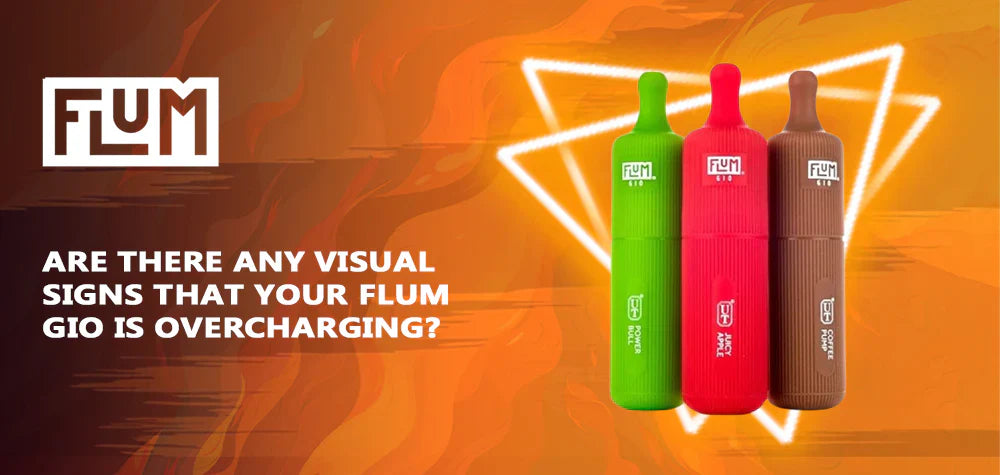
Are There Any Visual Signs That Your Flum Gio is Overcharging?
Overcharging is a concern for any rechargeable device, including the Flum Gio vape. While modern devices often incorporate safety features to prevent overcharging, it can still occur due to faulty chargers, damaged batteries, or improper charging habits. Detecting overcharging early is crucial to avoid permanent battery damage or safety hazards. This article explores whether there are visual signs that your Flum Gio is overcharging, explains how to interpret these signs, and offers guidance on maintaining your device's battery health.
Understanding Overcharging and Its Effects on the Flum Gio Battery
Overcharging happens when a battery continues to receive electrical current after reaching full capacity. Although the Flum Gio is designed with built-in protections to stop charging once full, these systems can fail or be bypassed by using incompatible chargers or damaged cables. When overcharging occurs, the battery cells are subjected to excessive voltage and heat, which can degrade the battery's internal chemistry and reduce its lifespan.
One of the most immediate and observable effects of overcharging is that the device often overheats while charging. This overheating is not just uncomfortable but also a warning sign that the battery may be under stress or damaged. Over time, continuous overcharging can lead to more severe consequences, including swelling, leakage, or even risk of fire.
Visual Signs That May Indicate Your Flum Gio Is Overcharging
Detecting overcharging visually can be challenging because many symptoms overlap with normal wear or other issues. However, there are several visual indicators that users should be aware of as potential signs that the battery is damaged of overcharging.
One of the most apparent signs is swelling or bulging of the device's casing. Lithium-ion batteries, like those in the Flum Gio, expand when their internal structure is compromised, often due to overcharging or overheating. If you notice that your Flum Gio's body is distorted, the seams are separating, or the device feels unusually thick or misshapen, this is a serious red flag. A swollen battery is unsafe and requires immediate cessation of use.
Another visual cue is discoloration or burn marks near the charging port or battery area. Excessive heat generated during overcharging can cause plastic or metal components to discolor, warp, or even melt slightly. If you observe any darkened spots, melted plastic, or corrosion around the charging port, it indicates that the battery or circuitry has been exposed to abnormal heat or electrical stress.
Cracks or physical damage around the charging port may also suggest that the device has been subjected to stress, potentially linked to improper charging practices. While not exclusively a sign of overcharging, damage in this area can contribute to poor electrical contact, leading to overheating and battery damage.
Interpreting Charging Indicators and Behavior
The Flum Gio features LED indicators that provide valuable information about charging status. Normally, when the device is charging, the LED light will illuminate or blink in a specific color (often red or blue), and once fully charged, the light will change color or turn off. If you notice irregular LED behavior, such as flickering, rapid blinking, or the light remaining on indefinitely, this could signal charging circuit issues potentially caused by overcharging or battery damage.
While these LED signals are not strictly visual signs of overcharging, they are important cues that your device may not be charging properly and warrant further inspection.
Why Visual Signs Alone Are Not Always Enough
While visual signs can alert you to potential overcharging problems, they often appear only after significant battery damage has occurred. Many internal battery issues caused by overcharging, such as chemical degradation or loss of capacity, are not visible externally. Therefore, relying solely on visual inspection may not be sufficient to detect early or moderate overcharging damage.
For this reason, it is important to also monitor your Flum Gio's performance. Symptoms such as rapid battery drain, inability to hold a charge, or the device overheating while charging should prompt you to consider that the battery may be damaged from overcharging, even if no obvious visual signs are present.
Best Practices to Prevent Overcharging and Battery Damage
To avoid the risks associated with overcharging and to maintain your Flum Gio's battery health, always use the original charger or one recommended by the manufacturer. Avoid charging the device unattended or overnight, as prolonged charging increases the risk of overcharging.
Charge your device in a cool, well-ventilated area to help dissipate heat effectively. Regularly inspect the charging port for dirt or debris, which can interfere with proper charging and cause overheating. If you notice any visual signs of damage or abnormal behavior, discontinue use immediately and seek professional assistance.
When to Seek Professional Help or Replace Your Device
If you observe any visual signs such as swelling, discoloration, cracks, or persistent abnormal LED behavior, these are strong indicators that your Flum Gio's battery may be compromised due to overcharging. Continuing to use a damaged battery can be dangerous.
In such cases, do not attempt to repair the battery yourself. Contact the manufacturer's customer support or a qualified technician for evaluation. They can determine whether the battery can be safely replaced or if the entire device needs replacement to ensure your safety.
In conclusion, while there are some visual signs that your Flum Gio may be overcharging-such as swelling, discoloration, and physical damage-many symptoms of battery damage are internal and not immediately visible. Paying attention to these visual cues, alongside monitoring charging indicator behavior and device performance, can help you identify signs that the battery is damaged of overcharging early. Adhering to proper charging practices and seeking professional help when needed will ensure your device remains safe and reliable.


